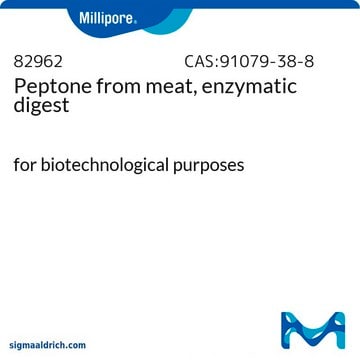70175
Peptone from meat, enzymatic digest
suitable for microbiology
Synonym(s):
Peptone from bovine meat
Sign Into View Organizational & Contract Pricing
All Photos(1)
About This Item
Recommended Products
biological source
bovine skeletal muscle
form
powder
technique(s)
microbiological culture: suitable
impurities
≥10% total nitrogen (N)
≥3% amino N
ign. residue
≤12%
loss
≤6% loss on drying
pH
7.0±0.5 (25 °C, 2% in H2O)
solubility
H2O: 2%, clear, slightly yellow
application(s)
food and beverages
microbiology
suitability
Clostridium spp.
Corynebacterium spp.
Salmonella spp.
Staphylococcus spp.
Looking for similar products? Visit Product Comparison Guide
General description
A specialized peptone prepared by the enzymatic digestion of selected fresh meat which can be used in media for the production of bacterial toxins from organisms such as Corynebacterium diphtheriae, Staphylococci, Clostridiae, and Salmonellae.
Application
Peptone from meat, enzymatic digest has been used:
- to culture Candida albicans
- to study its effects on canonical and non-canonical receptors of glucagon-like peptide 1 (GLP1) in human colon tissue in different ex vivo models
- as a component of the nutrient broth (NB) to study its efficacy against pathogen resistance in grapevine plants
Storage Class Code
11 - Combustible Solids
WGK
WGK 3
Flash Point(F)
Not applicable
Flash Point(C)
Not applicable
Personal Protective Equipment
dust mask type N95 (US), Eyeshields, Gloves
Choose from one of the most recent versions:
Already Own This Product?
Find documentation for the products that you have recently purchased in the Document Library.
Customers Also Viewed
Martina Cappelletti et al.
Frontiers in plant science, 7, 1053-1053 (2016-08-04)
Protein derivatives and carbohydrates can stimulate plant growth, increase stress tolerance, and activate plant defense mechanisms. However, these molecules can also act as a nutritional substrate for microbial communities living on the plant phyllosphere and possibly affect their biocontrol activity
Carme Grau-Bové et al.
International journal of molecular sciences, 23(7) (2022-04-13)
GLP1 produced in the upper part of the gut is released after food intake and acts by activating insulin secretion, but the role of GLP1 in the colon, where it is predominantly produced, remains unknown. Here we characterized the apical
GSPE Pre-Treatment Exerts Long-Lasting Preventive Effects against Aging-Induced Changes in the Colonic Enterohormone Profile of Female Rats.
Migu??ns-G??mez, et al.
International Journal of Molecular Sciences, 24 (2023)
Olena P Ishchuk et al.
Antibiotics (Basel, Switzerland), 9(1) (2020-01-08)
The opportunistic human fungal pathogen Candida albicans relies on cell morphological transitions to develop biofilm and invade the host. In the current study, we developed new regulatory molecules, which inhibit the morphological transition of C. albicans from yeast-form cells to
Our team of scientists has experience in all areas of research including Life Science, Material Science, Chemical Synthesis, Chromatography, Analytical and many others.
Contact Technical Service












